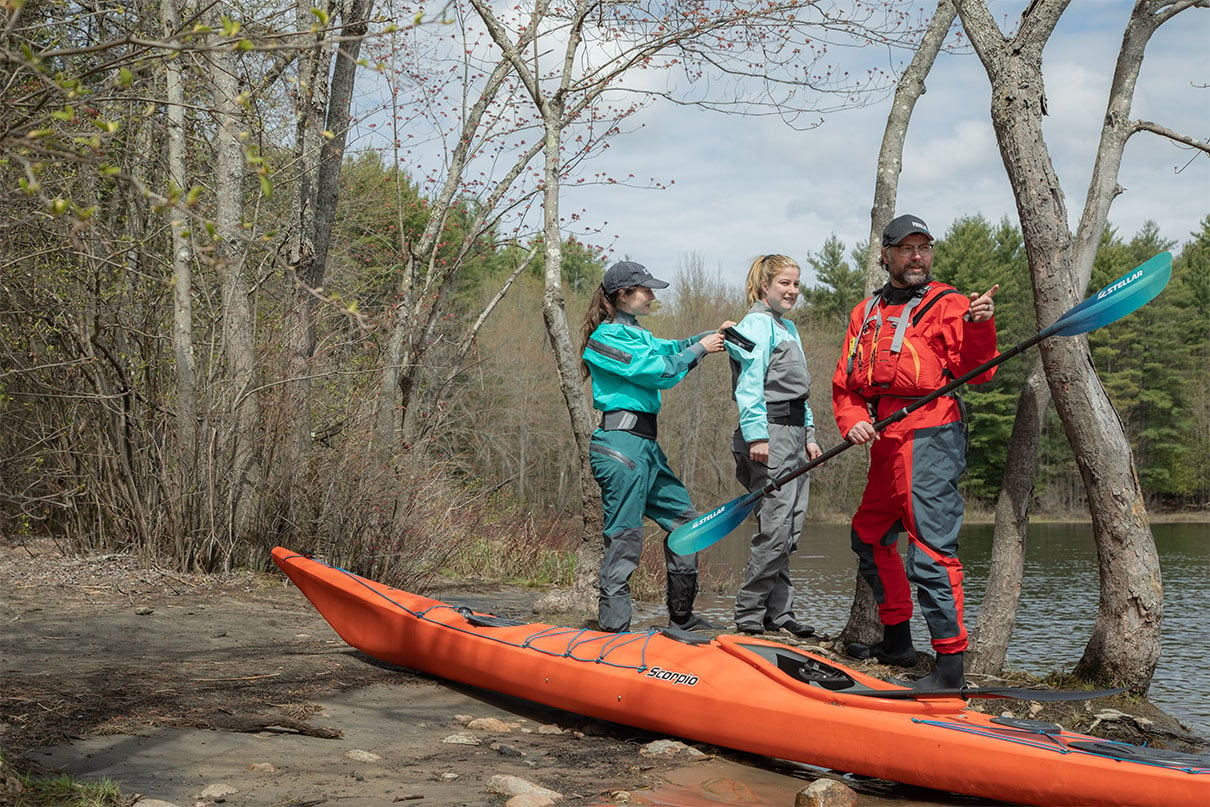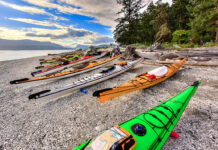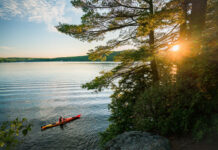We’re standing at a trail junction in the October rain, stuffing our faces with trail mix. It’s a damp, cold, off-season backpacking trip sometime in my young adulthood. Four hikers are climbing the switchbacks below us, clad in red rain gear with black patches on the shoulders and elbows. “Uh-oh,” my friend says. “Here comes the Gore-Tex mafia.” Three decades later, Gore-Tex and its distinctive look is still with us, but in light of the material’s high price, is Gore-Tex worth it?
In praise of waterproofing progress
First of all, I know of no link between Gore-Tex and Vito Corleone. Second, I love Gore-Tex. I live in one of the wetter and windier places in North America. Gore-Tex keeps me dry. In the days before waterproof-breathable shells, rain gear made me wetter on the inside than the outside.
My Gore-Tex drysuit extends my paddling season from five months to 12. It improves my overall paddling experience more than skegs or carbon fiber paddles. But like all revolutionary inventions, Gore-Tex came with complications and unintended consequences—it accentuated class divides in the outdoors.
Roughing it in the rain
When Gore-Tex first came out in 1976, I was in high school, just venturing out on my first backpacking trips on my own. Outdoor gear consisted of olive-drab itchy wool pants, rubber rain slickers and giant fluffy wool socks. Gore-Tex was, of course, both better and more expensive.
It was the first serious “outdoor technical clothing” and it helped bring outdoor gear from army surplus stores to specialized retailers. It also had a distinctive look. That’s why my pal and I could stand atop a damp ridge and estimate the tax brackets of hikers far below, and know it was higher than ours.
Waterproof fabric and the social divide
As the saying goes, timing is everything. Gore-Tex arrived as class divides were coming into sharp relief elsewhere. The first Gore-Tex jacket entered the hearts and minds of the outdoors world in earnest in the ‘80s. That’s when America also plunged into the world of supply-side Reaganomics, Gordon Gekko, Ivan Boesky, and the S&L Crisis.
Class divides in the outdoors is particularly irksome, since it’s supposed to be equal ground. Stephen Mather, the first head of the U.S. National Park Service, saw campgrounds and trails as places where visitors of all backgrounds could rub elbows. There were enough things to divide us. Fabric didn’t need to be one of them.
Fast-forward three decades. Virtually every outdoor apparel company has come out with their own proprietary waterproof-breathable fabric. But Gore-Tex, a closely guarded trade secret that has gone through many iterations, remains at the top of the heap in price and prestige. Like all our gear, it has evolved—my first drysuit had no waterproof socks or relief zipper. You can imagine how well that worked after three cups of coffee. Things are much better now.
Gore-Tex is still a big investment
However, the economic divide Gore-Tex put on display is still with us. The Gini Coefficient, a measure of income inequality, has climbed like an ever-flooding tide in the U.S. and Canada since 1980. Yes, people spend a lot more money on golf, downhill skiing and sailing, but sea kayaking gear is still expensive for the average American household earning $56,000 a year. The average Gore-Tex drysuit costs close to two percent of that. This has a chilling effect on gear designed to keep adventurers warm and dry. According to the annual Outdoor Participation Report, the cost of gear is the second highest reason people don’t participate in outdoor recreation. More than 40 percent of the people who do are making $75,000-plus salaries, according to the same report.
Faced with the expense, most new paddlers try to save a few bucks with a more budget-friendly option. They may buy a wetsuit or a drysuit made from other materials, which, in my experience, doesn’t compare. Sooner or later, many admit defeat and plop down the big bucks. I did the same for many years until I sucked it up and paid more than twice as much for my first modern drysuit as I did for my first used kayak.
So, is Gore-Tex Worth It?
More analysis may give the lie to the expense myth. I started paddling in earnest about 30 years ago, and I’m only on my second drysuit. After getting a bit soaked on a hike recently, I finally admitted my Gore-Tex mountaineering jacket was wearing out and grimaced at the cost of replacing it. That bugged me until I looked at my refrigerator. On the fridge is a photo of me standing on the summit of a glaciated peak, wearing that same jacket. I’m waving my ice ax and smiling at the camera with a face with less grey hair and fewer wrinkles than I have now. That photo was taken 18 years ago.
This article was first published in Issue 58 of Paddling Magazine. Subscribe to Paddling Magazine’s print and digital editions, or browse the archives.
Guaranteed to keep you dry and looking like a Power Ranger. | Feature Photo: Virginia Marshall










I would agree on all points. However, although I had to save up to make the purchase, the Kokatat Goretex dry suit I bought in 1994 is still going strong and was worth every penny it cost me to purchase AND maintain. It may not be in a modern stylish color (unless sun faded yellow and light blue has suddenly gained style points) but it still works better than cheaper nylon suits. I have spent money to keep it usable – periodically replacing the rubber gaiters as well as having Kokatat add a relief zipper that wasn’t even an option when I bought it. I hope to get 10 more years out of it.
Gore-tex is just another Iphone. All hype and no substance.
What do you use for rain gear/paddling gear Phil? Seems your comment is lacking substance.
I disagree with you Phil. I have tried many other “breathable” waterproof fabrics. NONE of them breathe like Gore-Tex and all have left me wet and cold. The only reason I have retired any of my Gore-Tex gear is that over the years I have “outgrown” some items. And I have always been happy to replace them with similar Gore-Tex items. One of my most painful losses in life was a North Face Gore-Tex mountain parka that was in luggage that was stolen on a business trip – and I count two ex-wives among those losses. Gore-Tex has been much more dependable.
Phil: do you suggest anything better? I have a dry suit with Gore-Tex, hiking boots with Gore-Tex and other gear. It has successfully kept me dry in a very wet part of Alaska.
Nah… After 40+ years (from Nahanni 1981-2019 & Nunavik 2007-2016) , and MANY iterations of raingear and drysuits, IMHO, Gore-Tex still works the BEST – darn it($!).
Search Landltrips (as one word) for some pretty serious wet/wild trips that my Gore-Tex has kept me safe & comfortable on …as much as is possible in those freakin’ COLD, WET, northern conditions… I’m a believer…
Goretex still leads the pack in performance and durability. Neil’s description of a jacket with shoulder patches is a bit misleading. You can’t see the goretex as it is laminated inside the outer fabric. What you get with goretex that is better is long term durability, a guarantee from both goretex and the manufacturer of the garment, and the laminate is inert to things like stove fuel. So goretex is the most tested and long term best performing waterproof breathable laminate. the guaranteed to keep you dry is a bit misleading also. It keeps you dry from the outside. When the relative humidity is 100%, as it is any time there is precip, you can’t push water through from the less than 100% humidity inside to the 100% humidity outside. But in the cold dry winter conditions outside your garment and the warm moist conditions inside you can move that moisture. And I agree with Neil that compared to my first seam sealed non breathable drysuit ( read plastic bag breathability) goretex is vastly more comfortable. I put on a damp fleece bib and top under my dry suit and rowed it dry through a mix of rain, sleet, wind and sun on the Tatshenshini. My goretex drysuit is now 18 years old and with a little tlc from Kokatat is still going strong. Maybe your vehicle has lasted that long but not many things match up.
I have done spring open canoe white water paddling (tandem and solo) in both a wet suit and a dry suit. The dry suit is much better and I’ve had mine for over 16 years. Use it spring and fall. Even with Aquaseal on the bootie joints, my feet get a little damp, but I can drive home in the clothing I paddled in. No neet to get naked and take off all that wet stuff to change into a dry outfit. A gor-tex drysuit takes a lot of the consequences out of a swim and you hardly even notice splashes.
The article never did answer the question – is Gore-Tex worth it? It was all about social status???
And lets not forget the often amazing warranty on Gore-Tex fabric. I’ve had 2 drysuits completely warrantied after numerous years of usage when the fabric had some functionality issues, with very little struggle at my end. An added bonus to going with Gore-Tex.
Awesome article. So nice to see people touching on the class and how it intersects with outdoor adventure.
I have a pair of $160+ Propet Gortex hikers that do not keep my feet wet even while hiking only in wet grass or weeds… no need to try them in puddles or streams. They are relatively new, not worn for years. The first test I gave them, on a forest trail, no puddles but wet vegatation, left the soles of my socks WET. Can’t find any holes in the uppers or soles, but definitely NO waterproofing happening.
Had a previous pair of New Balance hikers that were good when new, but eventually started leaking also.